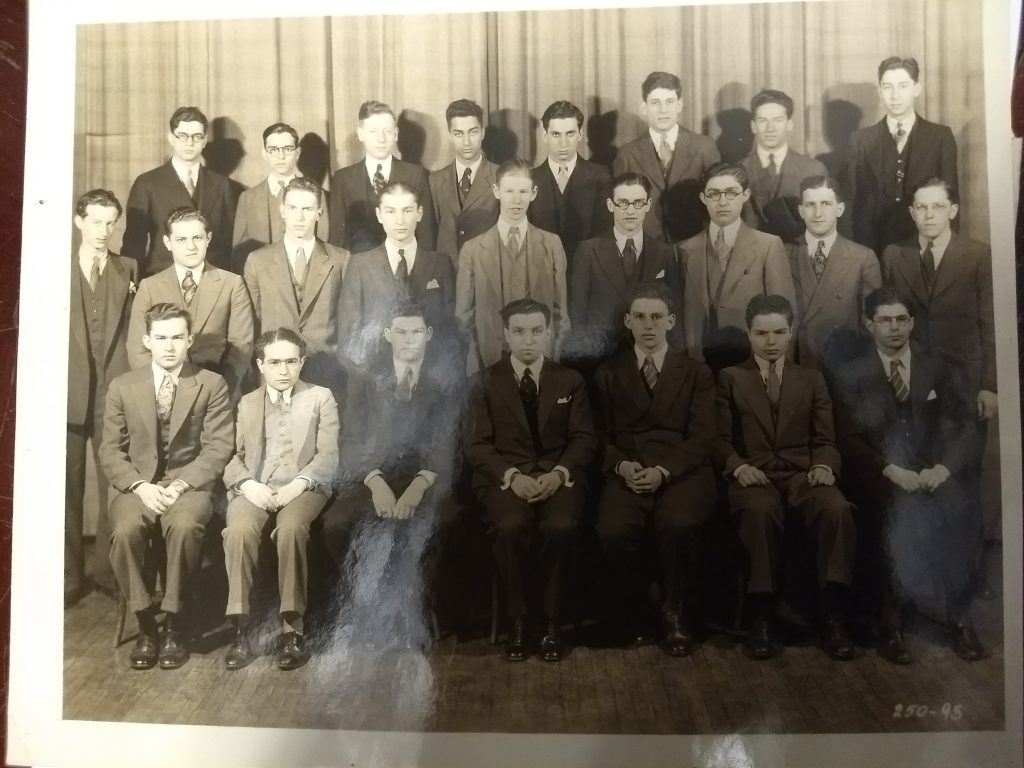
In honor of Jewish American Heritage Month (May), we’re highlighting unique materials relating to the history of the Jews in the Americas. In the past, of course, we’ve discussed the 18th century history of Hebrew and Jewish materials in the Columbia context, but the vast collections in the Rare Book and Manuscript Library highlight many aspects of the diverse Jewish American experience.
We can start with a uniquely Columbia story about Kings’ College President Myles Cooper acting as a courier, taking a Bible manuscript owned by a Jew named Sampson ben Joseph Simson in New York to London for the use of Benjamin Kennicott in his monumental work on the Hebrew Bible in the late 18th century. Simson’s nephew, also called Sampson, gave a commencement address in Hebrew at Columbia in 1800 which was written with the assistance of Gershom Seixas, the Jewish Columbia Trustee from 1787-1815. (For more on the address, see: Isidore S. Meyer, “The Hebrew Oration of Sampson Simson,” in Publications of the American Jewish Historical Society, Vol. 46, No. 1 (September, 1956), pp. 51-58).
Because the Columbia collection is a relatively old one within the American context, there are quite a few materials that speak to American Jewish Heritage. On the left is an example from the Park Benjamin collection – a Discourse, delivered at the Consecration of the Synagogue of [She’erith Israel] in the City of New York (April 17, 1818). Shearith Israel was originally built in 1730, and is the oldest building in continental North America to be built specifically as a synagogue. Mordecai Noah’s speech was given on the occasion of the synagogue’s move from its first location on Mill Street (now South William Street in the Wall Street district of New York City) to a larger location on the same block.

An unusual manuscript, written on cheap paper, and with the name of a street on each page, is a list of Jews living in New York between 1892 and 1893. Possibly compiled by a charity collector from Palestine, the book, lists almost 700 names of Jews on the Lower East Side and Brooklyn, along with what seems to be the amount donated:

Jews in New York
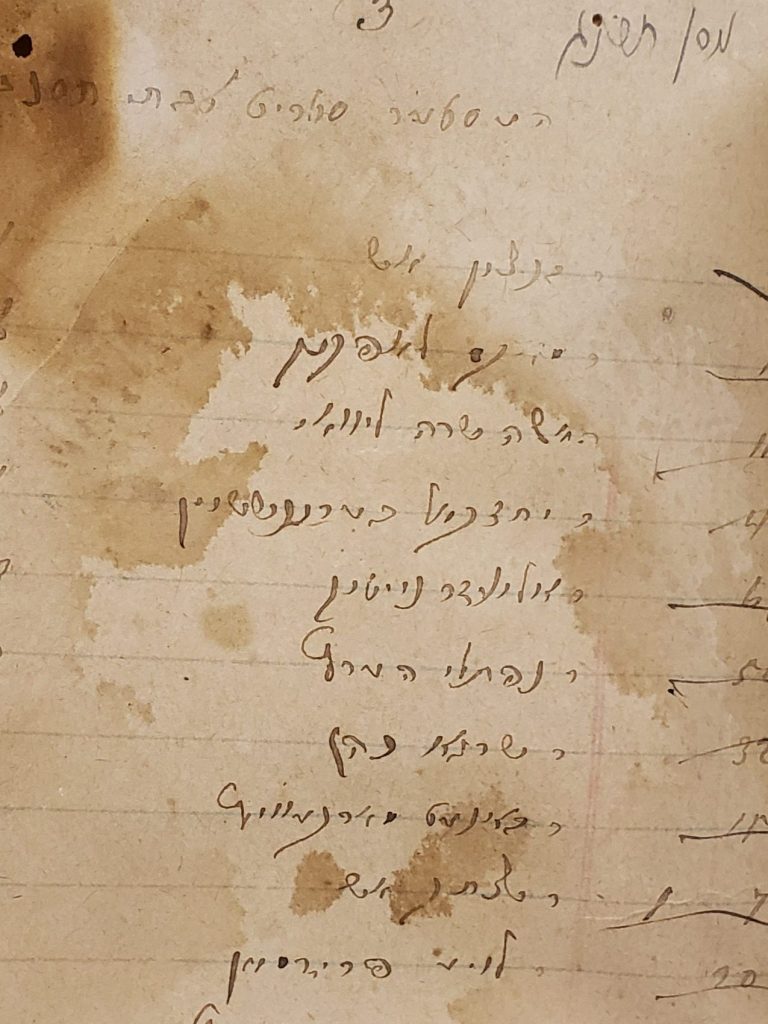
Jews in New York

Jews in New York
A volume produced by the Ladino paper La Amerika around 1912 shows the multilingual universe of Jews in the United States. The paper produced a small phrasebook called Livro de embezar las lingwas Inglezah i Yudish to help its readers acclimate to life in America. The phrases were transliterated into English in Hebrew characters, translated directly into English, and translated into Yiddish. Translating and transliterating (for those who did not read Latin characters) the phrases into English is understandable – but why Yiddish? At that time, even a Ladino speaker in New York city would have had to interact with some of their Yiddish-speaking co-religionists in order to obtain the items needed to practice Judaism – like kosher meat or matza for Passover – and this phrasebook would help them do it! The section at the end of the book, with questions for the US citizenship test, was translated into English only (Ladino and Yiddish speakers were more likely to speak about renting rooms, as below, than about the citizenship test!)

Jewish Education in New York City is a thesis written by Alexander Dushkin for the Philosophy Department in 1918. It includes multiple maps, tables, and other data, highlighting the state of Jewish education in New York in the early 20th century.


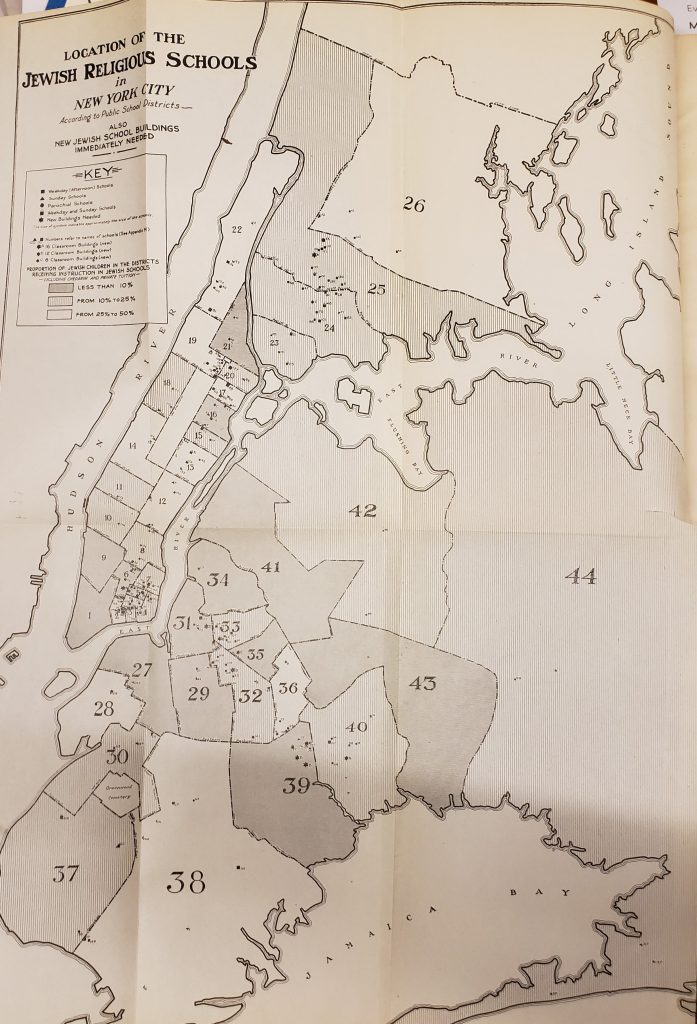
Early 20th century scholarship at Columbia under Richard Gottheil, Salo Baron and Arthur Goren included many theses on Jewish life in America. Some notable ones include Samuel K. Joseph on Jewish Immigration to the United States from 1881 to 1910 (in 1914); Isaac B. Berkson’s Theories of Americanization ; a critical study; with special reference to the Jewish group (1920), Helen Hadassah Levinthal’s The Jewish fraternal order : an Americanizing and socializing force (1932); Beryl Harold Levy’s Reform Judaism in America ; a study in religious adaptation (1933); Hyman B. Grinstein on The rise of the Jewish community of New York, 1654-1860 (1945) Abraham Meyer Rogoff on the Formative years of the Jewish labor movement in the United States (1890-1900) (1945), Harry Garfinkle on Idealogical elements in the development of the American Yiddish school movement (1954) and many more.
Other theses made their way into Columbia’s collections, highlighting the interest in Jewish life in America to Columbia’s faculty and students: Lee Levinger’s The causes of anti-Semitism in the United States : a study in group and sub-group (University of Pennsylvania, 1925), Nathan Marvin’s The attitude of the Jewish student in the colleges and universities towards his religion ; a social study of religious changes (University of Pennsylvania, 1932), and a rather chilling thesis (given the date) by Donald S. Strong out of the University of Chicago on Anti-revolutionary, anti-Semitic organizations in the United States since 1933 in 1939.
A number of archival collections deal with Jewish immigration and Jewish life in America in the early 20th century. The Lillian Wald Papers address major reforms and social services provided to the new immigrants; the Community Service Society Papers include an extensive photo archive (much of which has been digitized) documenting immigrant life, including many Jews. The Julius Samuel Wulbert Papers address (among other things), “a conflict within the Chicago Jewish community in 1915-16”; the Albert Lasker papers deal with quite a bit of Jewish philanthropic activity, including the creation of a Jewish farm in Pennsylvania that allowed for the training of poor Jewish immigrants in agriculture; and the Fort Ontario Emergency Refugee Shelter collection document the only Jewish refugee camp in America during World War II, in Oswego (upstate New York).

A wonderful example of Jewish institutions in the United States can be found in our Book Arts collection, in the form of a chess board (above) created in 1876 at the Industrial School of the H.O.A. (Hebrew Orphanage Asylum). The HOA, located in New York, was a short-lived industrial School that taught printing and other trades to its students. The tiny letters inside the white squares detail instructions for playing the game and information about its history – some examples are below:
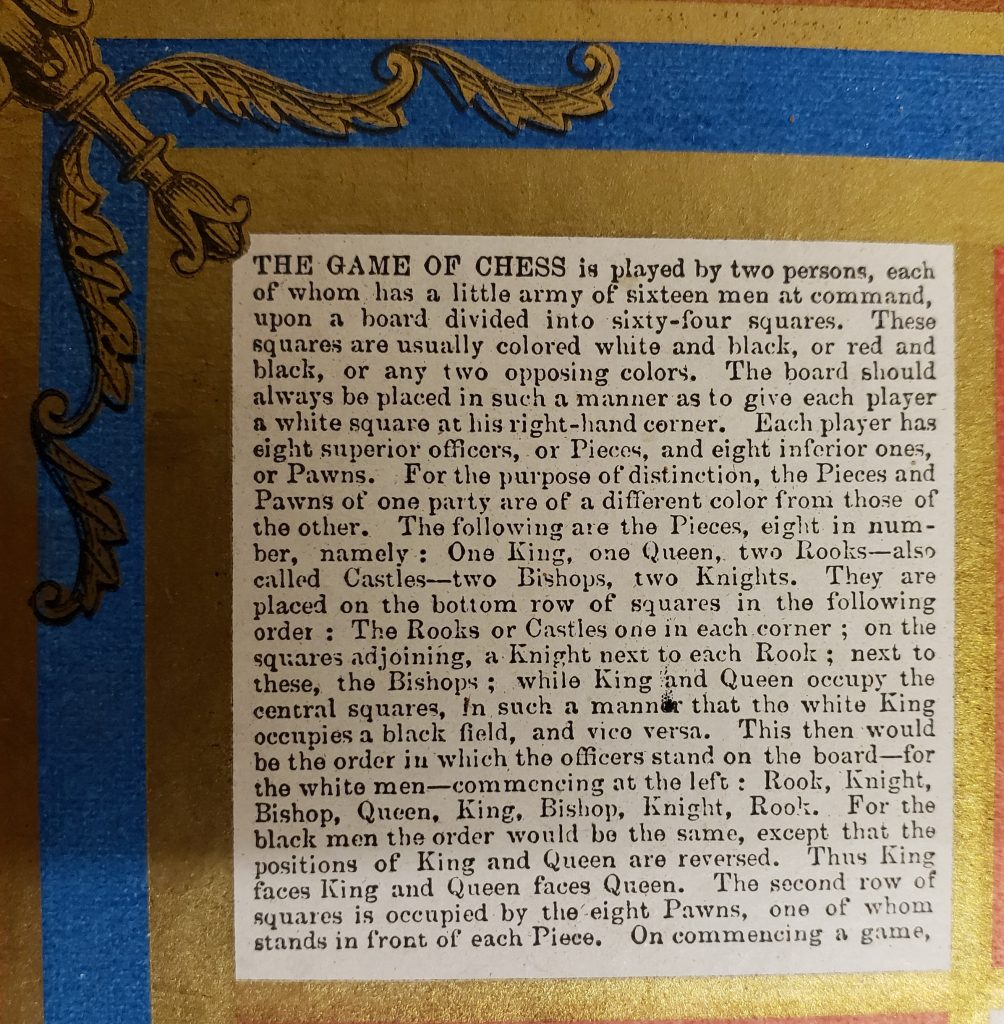
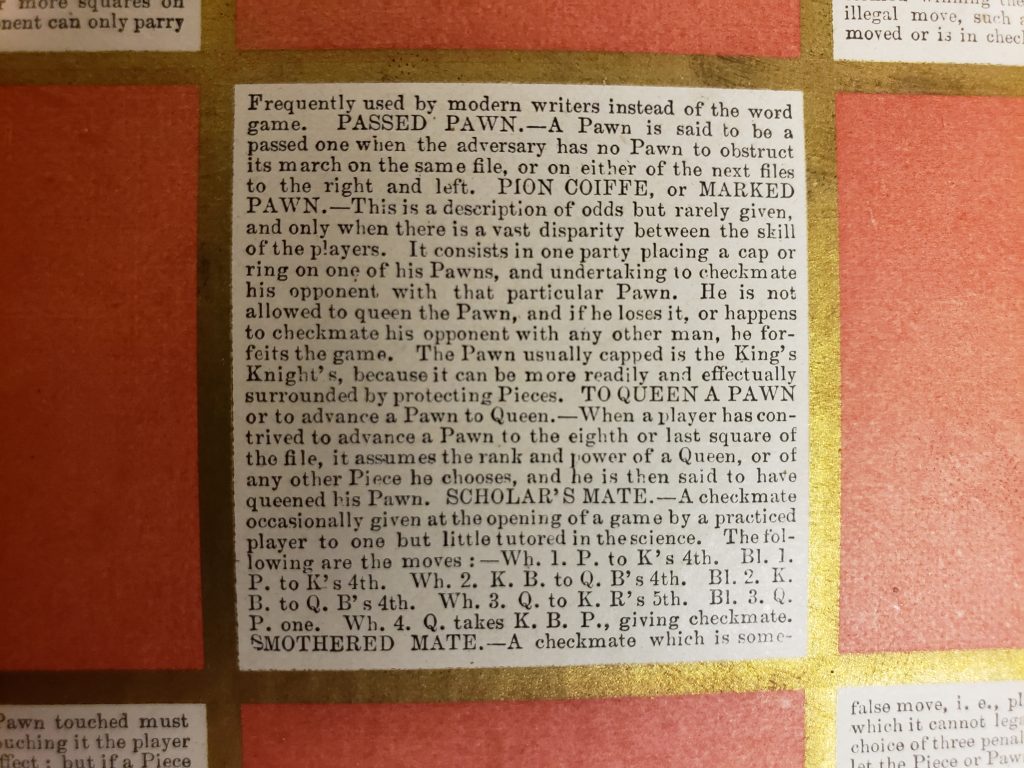

Moving beyond the United States to the Caribbean, a portion of a major collection donated to Columbia by Temple Emanu-el in 1892 includes the library of the Surinamese rabbi M. J. Lewenstein (1829-1864). Although his tenure as Rabbi was cut short due to his untimely death at the age of 35, we have about forty-five books in the collection that have been identified as coming from the Lewenstein collection, and are identified as such in CLIO. Among the Judaica manuscripts is a small volume (below) from 1810 containing prayers for the Jewish community and the rulers of Suriname. As a Dutch colony, Suriname was affected by the Napoleonic upheavals in the late 18th and early 19th centuries in Europe. It was during this time, when Suriname was under temporary occupation by the British, that this prayer was written. The poignant text, written in both Hebrew and Dutch, begs for forgiveness, success, and redemption, as well as benedictions for the king and the government leaders.
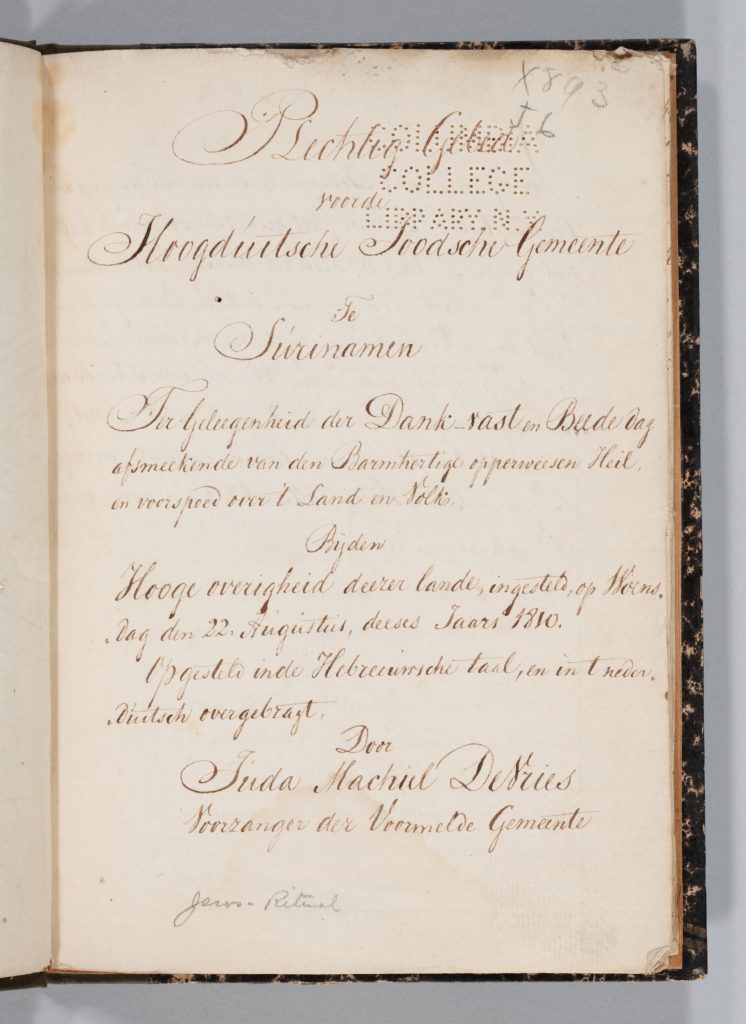
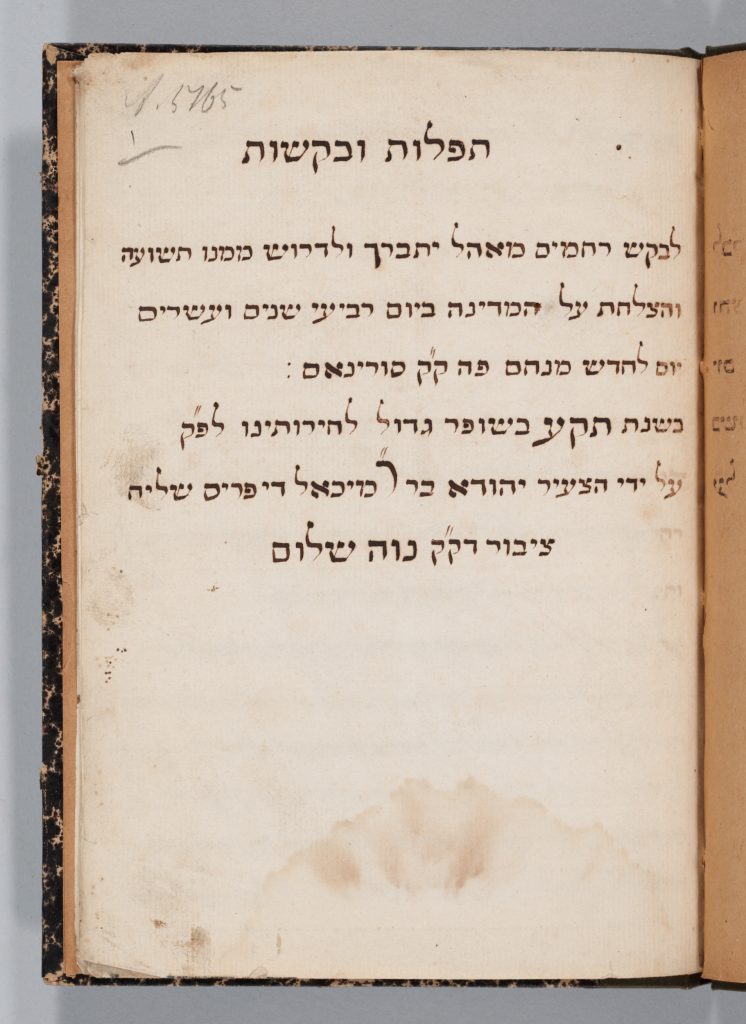
There are, of course, many, many examples of American Jewish heritage and culture found in the Norman E. Alexander Library for Jewish Studies. This small sampling gives a bit of an insight into some of the holdings in this rich collection.
This is fascinating.